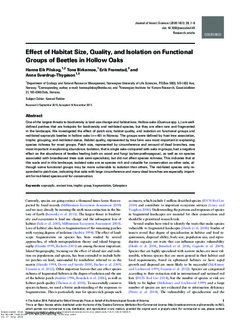| dc.contributor.author | Pilskog, Hanne Eik | |
| dc.contributor.author | Birkemoe, Tone | |
| dc.contributor.author | Framstad, Erik | |
| dc.contributor.author | Sverdrup-Thygeson, Anne | |
| dc.coverage.spatial | Noreg, Norge, Norway | nb_NO |
| dc.date.accessioned | 2018-07-19T08:39:31Z | |
| dc.date.available | 2018-07-19T08:39:31Z | |
| dc.date.created | 2016-07-11T11:43:28Z | |
| dc.date.issued | 2016 | |
| dc.identifier.citation | Journal of Insect Science. 2016, 16 (1), . | nb_NO |
| dc.identifier.issn | 1536-2442 | |
| dc.identifier.uri | http://hdl.handle.net/11250/2506091 | |
| dc.description.abstract | One of the largest threats to biodiversity is land use change and habitat loss. Hollow oaks (Quercus spp. L.) are welldefined patches that are hotspots for biodiversity and red-listed species, but they are often rare and fragmented in the landscape. We investigated the effect of patch size, habitat quality, and isolation on functional groups and red-listed saproxylic beetles in hollow oaks (n¼40) in Norway. The groups were defined by host tree association, trophic grouping, and red-listed status. Habitat quality, represented by tree form was most important in explaining species richness for most groups. Patch size, represented by circumference and amount of dead branches, was most important in explaining abundance. Isolation, that is single oaks compared with oaks in groups, had a negative effect on the abundance of beetles feeding both on wood and fungi (xylomycethopagous), as well as on species
associated with broadleaved trees (oak semi-specialists), but did not affect species richness. This indicates that at this scale and in this landscape, isolated oaks are as species rich and valuable for conservation as other oaks, although some functional groups may be more vulnerable to isolation than others. The red-listed species only responded to patch size, indicating that oaks with large circumference and many dead branches are especially important for red-listed species and for conservation. | nb_NO |
| dc.language.iso | eng | nb_NO |
| dc.rights | Navngivelse-Ikkekommersiell 4.0 Internasjonal | * |
| dc.rights.uri | http://creativecommons.org/licenses/by-nc/4.0/deed.no | * |
| dc.subject | saproxylic | nb_NO |
| dc.subject | ancient tree | nb_NO |
| dc.subject | trophic group | nb_NO |
| dc.subject | fragmentation | nb_NO |
| dc.title | Effect of Habitat Size, Quality, and Isolation on Functional Groups of Beetles in Hollow Oaks | nb_NO |
| dc.title.alternative | Effect of Habitat Size, Quality, and Isolation on Functional Groups of Beetles in Hollow Oaks | nb_NO |
| dc.type | Journal article | nb_NO |
| dc.type | Peer reviewed | nb_NO |
| dc.description.version | publishedVersion | nb_NO |
| dc.rights.holder | © The Author 2016. | nb_NO |
| dc.subject.nsi | VDP::Matematikk og Naturvitenskap: 400::Zoologiske og botaniske fag: 480 | nb_NO |
| dc.source.pagenumber | 8 | nb_NO |
| dc.source.volume | 16 | nb_NO |
| dc.source.journal | Journal of Insect Science | nb_NO |
| dc.source.issue | 1 | nb_NO |
| dc.identifier.doi | 10.1093/jisesa/iev145 | |
| dc.identifier.cristin | 1367381 | |
| cristin.unitcode | 7511,6,0,0 | |
| cristin.unitname | Oslo | |
| cristin.ispublished | true | |
| cristin.fulltext | original | |
| cristin.qualitycode | 1 | |

